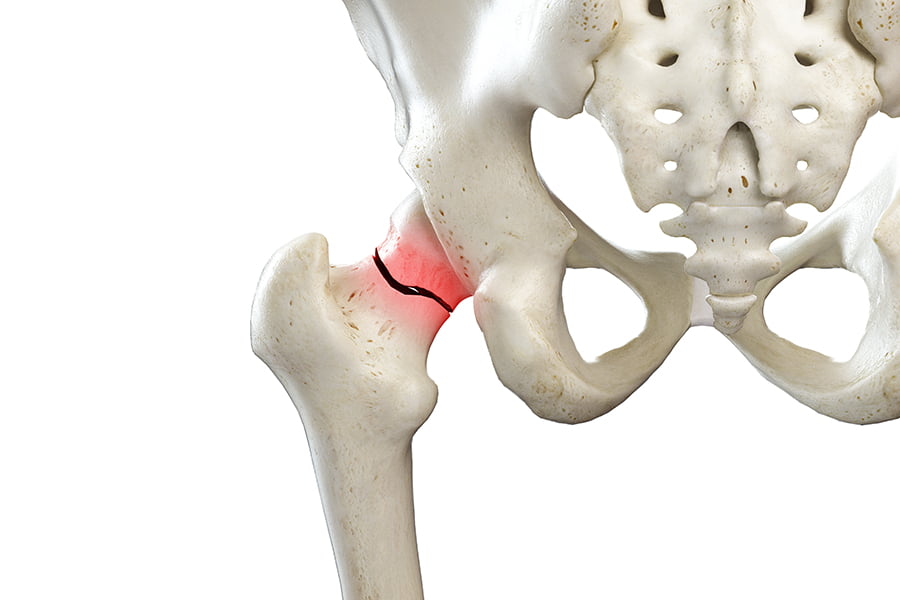Hip Fractures
Hip fracture Treatment in Spartanburg, Duncan and Greenville, SC
Orthopedic Hip Doctor in Spartanburg, SC, Duncan, SC, and Greenville, SC
Despite the robust bones and muscles encompassing the hip, injuries remain a common occurrence, influenced by factors such as the nature of the activity, individual age, and health history. The experts at Carolina Orthopadic and Neurosurgical Associates are here to help you navigate the need for hip surgery after a fracture.
Will I Need Surgery After A Hip Fracture?
A hip fracture, a break in the upper part of the femur near its connection with the pelvis, can significantly impact mobility, weight-bearing, and daily activities such as walking, standing, or sitting.
Prompt consultation with a Carolina Orthopaedic and Neurosurgical Associates (CONA) hip specialist is crucial after an accident or injury leading to hip fracture symptoms. Depending on the severity, orthopedic hip surgery may be necessary.
What Are The Symptoms and Causes of a Hip Fracture?
Hip fracture symptoms, such as a sudden fall, manifest immediately after an accident or injury:
Symptoms of a hip fracture may include:
- An outward turn to the affected limb
- Bruising
- Difficulty standing from a sitting position
- Difficulty bearing weight on the affected side
- Severe hip and groin pain
- Stiffness and swelling
- Loss of range of motion
- Difficulty walking, increased imbalance
- Visible deformity of the affected area
Causes range from direct hip blows to falls, motor accidents, osteoarthritis, osteoporosis, and sports injuries.
How Are Hip Fractures Treated?
A CONA hip specialist diagnoses and formulates a treatment plan, considering nonsurgical options for non-displaced fractures, such as pain management, anti-inflammatory medications, immobilization, and physical therapy.
Displaced fractures may require surgical interventions like Open Reduction Internal Fixation (ORIF) or partial/total hip arthroplasty, where implants replace the bone to form a new, functional hip joint. Fractured bones heal and fuse over several months, with post-surgery physical therapy enhancing strength, flexibility, and function.
What Are The Risks of Hip Surgery?
The recovery time for hip fractures varies but involves ongoing monitoring, rehabilitation, and support. Risks associated with hip fractures include complications like infection, blood clots, or joint stiffness.
How Do I Know If I Need Hip Surgery?
CONA specialists employ a step-by-step approach, obtaining accident reports, conducting multiple-view x-rays, and performing a thorough physical examination. The accurate diagnosis helps determine the fracture’s severity, guiding the prescription of an appropriate treatment plan.
Will I Need Hip Surgery if I Have Osteoporosis?
Women over 50 experiencing hip pain are encouraged to consult a CONA hip specialist promptly to investigate if osteoporosis is the underlying cause. Early diagnosis is crucial for effective management, involving bone density testing and targeted interventions like medications, lifestyle adjustments, and nutritional guidance to enhance bone health. CONA’s commitment extends beyond initial diagnosis, offering holistic care to ensure comprehensive and successful recovery journeys.
Our Carolina Orthopedic & Neurosurgical Associates team is prepared to assist hip surgery patients in navigating the most suitable and effective paths to promote comprehensive healing and recovery, letting you get back to the things that matter in life. We serve patients from Spartanburg, SC, Duncan, SC, and Greenville, SC.

South Carolina Orthopedic Hip Surgery Locations
Spartanburg, South Carolina
1330 Boiling Springs Rd, Ste 1600
Spartanburg, SC 29303
Directions to Spartanburg
Hours: 8:00 a.m. to 5:00 p.m.
Contact us: (864) 501-0541
Duncan, South Carolina
115 Deacon Tiller Ct.
Duncan, SC 29334
Directions to Duncan
Hours: 8:00 a.m. to 5:00 p.m.
Contact us: (864) 362-3461
Greenville, South Carolina
220 Roper Mountain Road Ext
Greenville, SC 29615
Directions To Greenville
Hours: 8:00 a.m. to 5:00 p.m.
Contact us: (864) 582-6396

